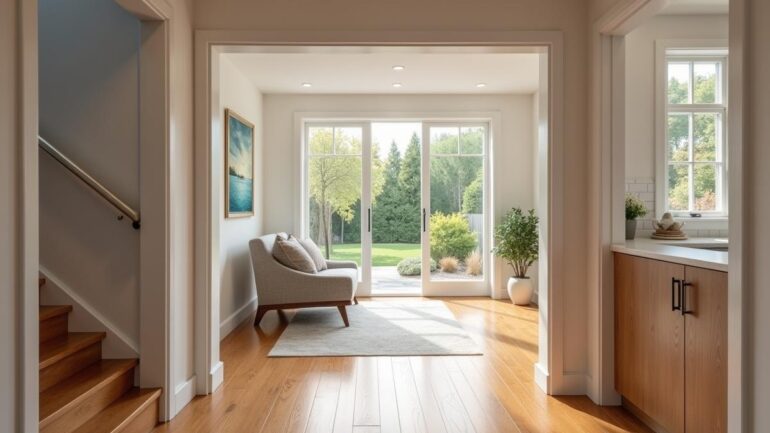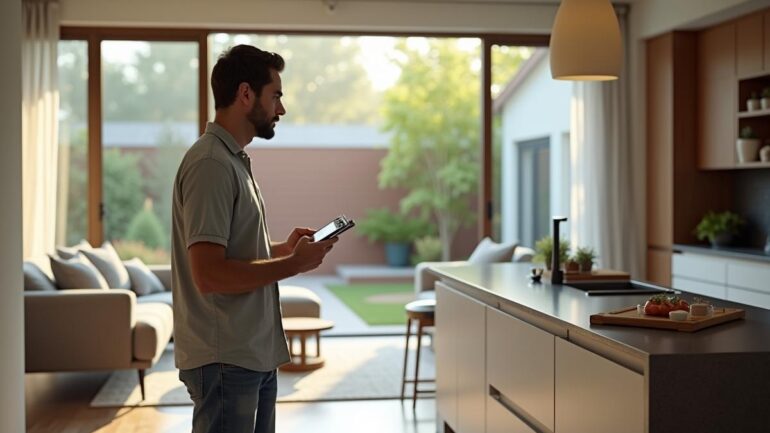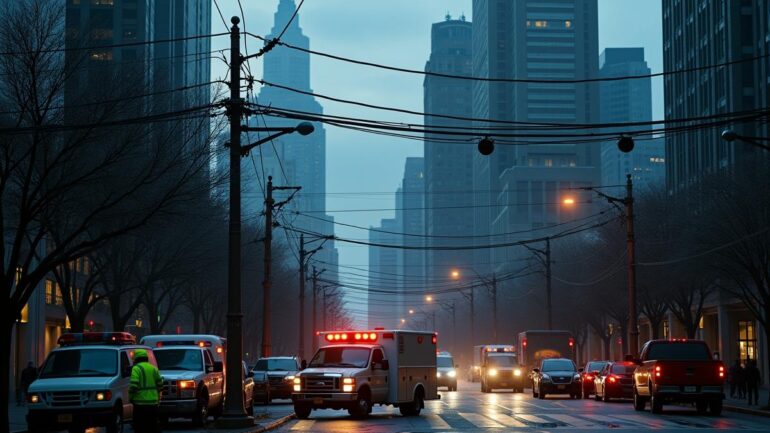Older adults can enjoy safe and welcoming spaces with creative home improvements. Whether it’s upgrading flooring, adding stability features, or rethinking outdoor areas, these changes can improve day-to-day life without compromising style.
Accessible home design done creatively
A well-planned home begins with accessible home design elements that cater to various mobility levels. Wide doorways, non-slip flooring options, and safety grab bars can blend seamlessly with modern interiors. Decorative railings or handrail installations can complement existing decor, making the house both beautiful and functional. Aging in place modifications often focus on small details like lever door handles for easy access, which reduce wrist strain and look elegant.
Subtle flooring solutions
Selecting non-slip flooring is a key step in preventing accidents and creating fall prevention home features. Engineered wood or textured vinyl can offer traction while adding warmth to living spaces. This type of flooring also suits aging in place renovations that need to accommodate wheelchairs or walkers. Beyond safety, it helps unify rooms, offering a cohesive look that suits a variety of interior styles.
Doorway expansions
Widened doorways for seniors are often overlooked until mobility becomes a concern. This step is critical for those using wheelchairs or walkers. It doesn’t have to stand out as a clinical feature; a simple trim upgrade can keep it visually appealing. With increased doorway width, moving about the home becomes more comfortable and less hazardous.
Making aging in place renovations more stylish
Many homeowners worry that accessible features might clash with their personal taste, yet modern designs have found ways to seamlessly integrate form and function. Senior safety features, such as grab bars installation, can be discreetly placed in hallways or bathrooms. You can match metallic finishes with faucets or towel racks, ensuring safety enhancements don’t look out of place.
Smart mobility solutions
Stairlifts for seniors can become part of a sleek interior if selected with style in mind. Manufacturers now produce models that fold away, so steps remain clear. Another growing trend includes adjustable countertops that eliminate the need to stretch or reach too high. These kitchen modifications for seniors are not just practical; they can also serve as conversation pieces when guests admire their smooth operation.
Creative lighting tweaks
Senior-friendly lighting helps reduce eyestrain and increases visibility around the home. From unique table lamps to recessed fixtures, home lighting adjustments for elderly residents can be both functional and decorative. Automatic lighting systems for seniors can activate in dimly lit hallways or closets using motion sensors. Advanced LED bulbs provide energy-efficient upgrades that cut costs while brightening living areas.
Senior bathroom upgrades that blend style and comfort
Bathrooms are common spots for slips and falls, so investing in senior bathroom upgrades is wise. Try pairing modern tile with a low-threshold shower or a walk-in bathtub installation. These additions can feature attractive glass enclosures and stylish fixtures that turn ordinary bathrooms into spa-like sanctuaries. Incorporating bathroom safety improvements doesn’t have to mean installing garish rails or plastic seating—there are numerous elegant options available.
Safety with a dash of flair
Aging in place modifications for the bathroom often extend beyond tub or shower changes. Non-slip flooring in wet areas can match the rest of the home’s design, offering continuity. Additionally, smaller touches like built-in shelving, which eliminates clutter on counters, enhance stability. Even subtle painting techniques or accent tiles can direct attention toward decorative elements rather than solely focusing on accessibility features.
Thoughtful fixtures
Rotating shower stools, handheld showerheads, and sleek safety grab bars can all look cohesive with a chosen design scheme. Selecting finishes that mirror existing bathroom fixtures ties everything together. Look for water-resistant materials that ensure longevity, and consider universal design principles to future-proof these upgrades. By keeping the overall aesthetic consistent, you’ll have a welcoming space that serves function and style equally.
Kitchen modifications for seniors to ease daily routines
Few places see as much activity as the kitchen. To keep cooking enjoyable, consider installing pull-out drawers or convenient storage solutions for dishes and pans. These create easy-to-navigate floor plans that reduce awkward bending, turning, or climbing. With a well-planned layout, you maintain independence while preparing meals, even if your mobility changes.
Tech-savvy approaches
Smart home technology for seniors can simplify meal preparation. Voice-activated devices control lights, timers, and music with minimal effort. Automatic faucets reduce strain on wrists and can be set to dispense specific amounts of water. These small additions can be part of broader home automation for elderly family members looking for efficiency and peace of mind.
Leveraging creative countertop designs
Adjustable countertops can move up or down to suit multiple heights. This feature helps family members of different sizes use the same workspace comfortably. When combined with energy-efficient upgrades in appliances, such as induction stovetops, a kitchen can be both cost-effective and future-ready. A senior-friendly kitchen design ensures safety while still promoting creativity in cooking.
Outdoor accessibility and low-maintenance landscaping
The home exterior is just as important as the interior. A handicap accessible entryway can transform a front porch with a wheelchair accessible ramp that blends seamlessly into landscaping. Low-maintenance landscaping means residents spend less time on difficult yard work while still enjoying outdoor spaces. With careful selection of native plants and ground covers, you can reduce watering and weeding demands, leaving more time to relax.
Pathways and seating
Secure, well-lit walkways around the property provide confidence when strolling outdoors. Non-slip surfaces, combined with strategic handrail installations in any sloping areas, minimize risks. Installing sturdy benches or chairs in shaded spots encourages rest and relaxation, making the outdoors inviting for social gatherings. These features become part of a broader elderly home adaptation strategy that keeps nature within reach.
Rethinking entrances
Widened entrances with smooth transitions improve safety while carrying groceries or assisting visitors. A small overhang or porch covering shields the main entry from rain, preventing slick surfaces. You might also add motion-sensor lights or solar-powered fixtures for better visibility at night. These outdoor home accessibility upgrades not only enhance safety but also elevate curb appeal.
Embracing community support for seniors
Living independently doesn’t mean isolation from neighbors or local services. Community support for seniors, such as volunteer groups, can help with occasional heavy lifting or specialized tasks. Tapping into these networks brings social interaction and a sense of security. Many local organizations also offer workshops that share tips on aging in place modifications, ensuring you stay informed about new strategies and products.
Sharing experiences
Homeowners who successfully implement senior safety enhancements often inspire others to do the same. By hosting small neighborhood events or joining social media groups, you can demonstrate how older adults stay active and safe at home. Showing off creative design elements—like a clever fall prevention home feature—starts conversations that spark inspiration among peers. This sense of camaraderie fosters a communal approach to independent living.
Local resources
Some municipalities provide grants or subsidies for elderly home adaptation projects that align with universal design principles. Research local building codes to ensure your plans meet regulations, especially if you’re adding a wheelchair accessible ramp or adjusting your entryway. Consulting experts who specialize in home lighting adjustments for elderly homeowners could also yield valuable advice. When people pool their knowledge, everyone benefits from innovative solutions.
Smart home technology for seniors and personalized solutions
Incorporating modern innovations can significantly enhance comfort and convenience. Voice-activated assistants and doorbell cameras offer peace of mind, allowing residents to see who’s outside and communicate hands-free. Home automation for elderly individuals can include temperature control, so the home stays cozy without constant manual adjustments. Whether it’s a high-tech security system or a user-friendly thermostat, it all contributes to a personalized living experience.
Multifunctional devices
Technology doesn’t have to be complicated. Tablets can manage medication reminders, video calls, and even grocery lists. Some appliances connect to mobile apps, sending notifications about open refrigerator doors or stove burners left on. These senior safety features offer reassurance that everything is running as it should, even if dulled senses or memory issues creep in.
Increasing independence
Smart devices that respond to simple commands can reduce reliance on others for everyday tasks. Automatic lighting systems for seniors mean no one has to fumble for switch panels after dark. By integrating these solutions within existing decor, the technology blends into daily life. Moreover, other than just convenience, using medical alert devices can be important to senior safety. They can provide immediate access to help with just a button press, thus addressing situations like “I’ve fallen and I can’t get up”, or similar emergencies. This can ensure that help is always within reach. These technological advancements can ensure that independence stays within grasp for longer, promoting confidence and peace of mind.
Finding balance between function and style
Ultimately, the best results come from blending practical elements with personal taste. Many projects, from walk-in bathtub installation to wide doorways, can be accomplished with a creative flair. Even a small redecoration, like swapping out outdated hardware, can encourage confidence in using each room. Selecting complementary colors and contemporary designs for accessories ensures senior friendly home improvements remain stylish rather than clinical.
In any renovation project, focusing on ease of use fosters comfort for all ages. Hidden storage spaces, adjustable lighting, and thoughtful furniture arrangements make daily tasks simpler. Whether it’s planning a low-threshold shower or adding wheelchair accessible ramps, think about how to keep aesthetics appealing. When done intelligently, these upgrades can bring lasting benefits, enabling residents to gracefully maintain their independence at home.





